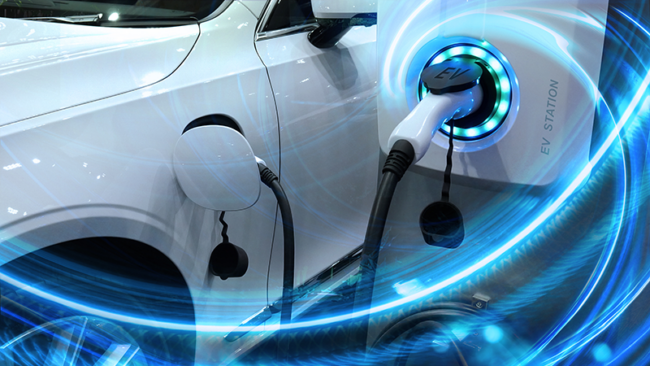Stay connected
Subscribe to our fleet blog and follow us on social media to receive all our fuel and energy industry insights.

Electric vehicles (EVs) are becoming ever popular among today’s consumers. As their adoption increases, so do questions about traditional vs. electric fleets, how the cost of maintenance compares, and whether now is the right time to start transitioning to a mixed or fully electric fleet.
Are EVs really more cost-effective than their gas-powered counterparts? What expenses are important to consider when converting your fleet to electric? Here, we’re talking about all things electrification as we compare costs associated with traditional internal combustion engine (ICE) fleets and fleets composed partially or primarily of EVs. This is everything you need to know.
When converting to an EV fleet or mixed fleet there are tools like the EV Fleet Converter to help you make your best transition plan. EV Fleet Converter is an interactive tool to help you determine how, if, and when to convert some or all of your fleet to EV. The tool allows businesses to enter information about their vehicles and receive estimated cost of ownership savings, emissions savings, potential incentives, and charger needs for electrifying their fleet. EV Fleet Converter shows a full range of available EVs and chargers and allows fleet operators to understand the feasibility, costs, and benefits of electrifying their fleet. EV Fleet Converter is available to all WEX customers via WEXOnline, free of charge and with no additional terms to sign. Watch this quick video for more information:
All vehicles require regular maintenance — whether they’re gas-powered or electric. However, it’s generally safe to assume that an electric motor will require less total maintenance over its lifetime and, therefore, is more cost-effective to maintain than a traditional gas vehicle.
When comparing the two types of vehicles, an EV has fewer mechanical parts overall than an ICE vehicle. This is a major contributing factor to maintenance costs, as fewer moving parts means less of a chance of part failure and less regular maintenance.
Here are a few quick, general facts to consider about EVs:
When taking into consideration parts and labor, the total cost to repair or replace brake pads can be anywhere from $100 to $300 per axle.
A traditional ICE vehicle typically requires new brake pads every 25,000 to 65,000 miles, while EV brake pads can last upwards of 100,000 miles.
The National Renewable Energy Laboratory of the United States predicts today’s EV batteries will have service lives of between 12 and 15 years in moderate climates. While EVs do require regular maintenance for parts such as brakes, tires, and more, the interval between necessary services is typically far greater than the interval experienced with ICE vehicles.
The cost of charging an EV is cheaper across the board compared to filling up an ICE vehicle with fuel. The comparison is not 1:1 when you account for how many miles each type of vehicle gets on a single fill-up or charge; however, there are tools available that account for these variables — like one created by Energy Innovation.
President Biden set a goal that by 2030, 50% of all new vehicle sales in the U.S. be electric. This aligns with a global goal to reach net zero greenhouse gas emissions by the year 2050, committed by organizations and nations throughout the world.
The Biden Administration is leading by example with EV adoption for some of the country’s largest fleets, and one example of that is the steps this administration has taken to adopt EVs into the U.S. Postal Service’s fleet. The government’s current goal is to electrify all new light-duty vehicles, like those driven by postal workers, by 2027.
As for medium- and heavy-duty vehicles, the U.S. government has committed to adding only electric vehicles to its fleets starting in 2035. Starting in 2035 no more ICE vehicles will be purchased for this category of fleets.
In alignment with the government’s commitment to transition to fully electric federal fleets, some U.S. states and cities have announced that by 2035 there will no longer be ICE vehicles sold in their states. The sale of such vehicles will be illegal.
To encourage businesses and individual drivers to transition to EVs, the U.S. Department of Energy offers a variety of incentives, rebates, and credits for new, clean vehicles purchased in 2023 or after. Depending on the size of your fleet, these incentives can be pretty lucrative.
Rebate amounts vary based on several factors. As an example, here’s one incentive being offered by Pacific Gas & Electric (PG&E) for the purchase of electric fleet vehicles:
As per the U.S. Department of Energy, this particular incentive program limits applicants to 25 electric vehicle rebates per site.
The Internal Revenue Service (IRS) is also offering an incentive for individuals and their businesses. However, an EV owner must meet critical mineral and battery component requirements, buy the EVs for their own use and not for resale, and drive primarily in the U.S. to qualify.
For vehicles placed in service on April 18, 2023, or after, credit amounts are as follows:
WEX helps you transition to a mixed or all-electric fleet through a variety of fleet management services and fuel card products. Whether you’re a large fleet, small business, or government body, WEX has everything you need to keep your vehicles moving.
Explore further with our
“EV 101” Infographic.
To learn more about electrification and other ways WEX helps organizations manage their fleet, get started today.
WEX is a leading, global fintech solutions provider, simplifying payments and back-end business processes in the fleet management, benefits management, and corporate payments areas. To learn more, please visit the company’s About WEX page.
Resources:
National Renewable Energy Laboratory of the United States
U.S. Government
WhiteHouse.gov
Brakes To Go
Energy Innovation
News Observer
U.S. Department of Energy
Internal Revenue Service
Subscribe to our fleet blog and follow us on social media to receive all our fuel and energy industry insights.